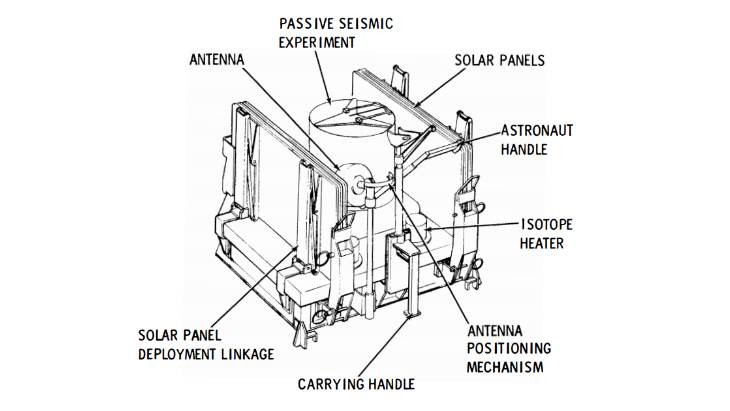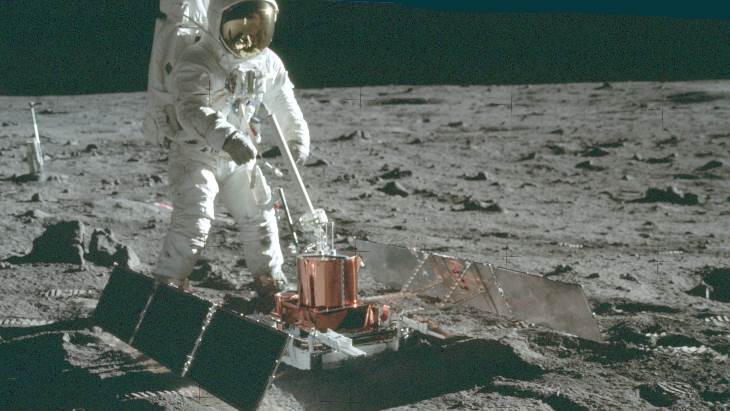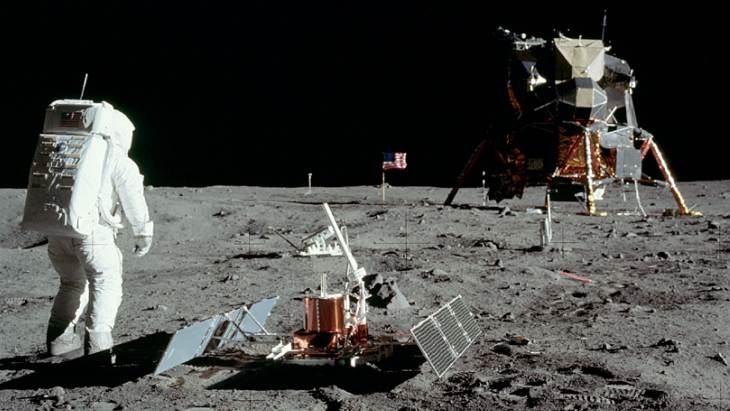"There you go. Good work; good show. Hey, whoa; stop, stop! Back up." Not quite as famous as 'One small step...' but nevertheless words said by Neil Armstrong on the surface of the Moon, 50 years ago this week. They were said to Buzz Aldrin as the two astronauts, nearing the end of their moonwalk and running out of time, hurried to set up a series of experiments on the lunar surface.
Originally it had been planned for a more complex set of experiments, called the Apollo Lunar Surface Experiments Package (ALSEP), to be carried on Apollo 11. These would have been powered by a SNAP-27 radioisotope thermoelectric generator (RTG), which would convert the heat energy from radioactive decay to electrical energy. However, initial plans for there to be two moonwalks during the Apollo 11 mission had been revised to just one - with the total time spent on the Moon's surface planned to be under three hours. The scientific experiments would need to be set up in just ten minutes. The intended Apollo Lunar Surface Experiments Package (ALSEP) would need to be simplified to allow deployment in that short timeframe.
The Bendix Corporation had been awarded the contract to develop the ALSEP in early 1966. They proposed a simplified set of experiments collectively termed the Early Apollo Scientific Experiments Package, or EASEP. These would utilise components that had been in preparation for the proposed Apollo 13 ALSEP. Instead of using an RTG for power, the EASEP would be powered by two solar panels, and therefore could only operate during the lunar day. The experiments would consist of a passive seismometer, designed to measure seismic activity and physical properties of the lunar crust and interior, and a lunar dust detector to measure dust accumulation.
Without protection, the suite of experiments would have been exposed to temperatures as low as -175°C during the lunar night. To overcome this, two isotope heaters (now more usually called radioisotope heater units) were included, built into the passive seismometer package. The two 15-watt heaters were attached to a thermal plate and were designed to keep components to a temperature higher than -54°C to ensure their required reliability. The heat they produced came from the radioactive decay of 36 grams of plutonium 238, at the centre of each of the heaters.

Schematic of EASEP in its stowed configuration showing the isotope heater (Image: NASA)
The heaters, developed by the Atomic Energy Commission, were the first major use of nuclear technology in a manned space flight mission. Each heater was 7.6 cm in diameter, 7.6 cm long, and weighed 57 g, including multiple layers of shielding and protective materials. The plutonium fuel was encased in various materials chosen for radiation shielding and for heat and shock resistance. These materials included a tantalum-tungsten alloy, a platinum-rhodium alloy, titanium, fibrous carbon, and graphite, with an outer layer of stainless steel. Extensive safety analyses and tests were performed by Sandia Laboratories at Albuquerque, New Mexico, to determine the effects of an abort or any conceivable accident in connection with the moon flight. The safety report by the Interagency Safety Evaluation Panel, made up of representatives of NASA, the AEC, and the Department of Defense, concluded that the heater presented no undue safety problem to the general population under any accident condition deemed possible for the Apollo mission.
Apollo 11 lifted off at 13:32 UTC (Coordinated Universal Time) on 16 July and landed on the Moon at 20:17 UTC on 20 July. At 2:56 UTC on 21 July Neil Armstrong, commander of the mission, stepped on to the lunar surface. At 4:25 UTC, Buzz Aldrin, the lunar module pilot, transported the scientific package about 17 m south of the Lunar Module and set up the equipment. The experiments were turned on by ground command while the astronauts were still on the surface, and data was first received at 4:40 UTC. The seismometer was able to detect the impact of articles discarded by the astronauts as they prepared to return to the orbiting command module.

One isotope heater can be seen just in front of Aldrin's left boot. (Image: Neil A. Armstrong/NASA)
The long lunar day meant that the solar panels provided power until a few hours before local lunar sunset on 3 August. During that first lunar day of operations, the seismometer recorded a number of events which appeared to scientists to represent seismic activity and/or rock slides down the sides of nearby craters. As night fell the isotope heaters began their task of providing enough heat to protect the experimental apparatus.
When the sun rose on the next lunar day - August 19 - Ground Control turned the instrument on again. The isotope heaters had worked successfully. The EASEP began reporting experimental data again. It continued to function until 27 August, when near the lunar noon and with temperatures at their highest, the EASEP ceased responding to commands from Earth stations and the experiment was formally stopped. However, some data continued to be received, and shortly after a second lunar night, the thermal plate reported a temperature of -47°C, compared to -152°C for the unprotected solar panel still in shade.
From Apollo 12 onwards, missions would carry the more extensive ALSEP. These would upgrade their power source to the SNAP-27 radioisotope thermoelectric generator, which allowed more extensive and continuous operation, with data being returned many years after the last astronaut had stepped on the Moon. Radioisotope heater units and radioisotope thermoelectric generators would go on to power and support some of the most successful space missions, including the Mars rovers and space probes sent to Jupiter, Saturn, Uranus, Neptune and Pluto, returning images and other data that have broadened our understanding and filled us with wonder.







_53514_33880.jpg)




